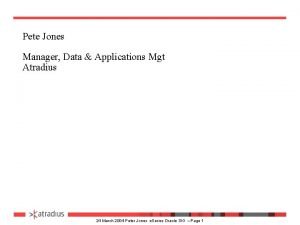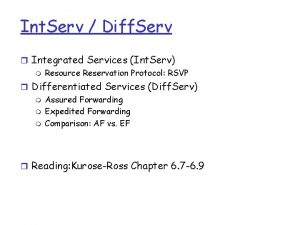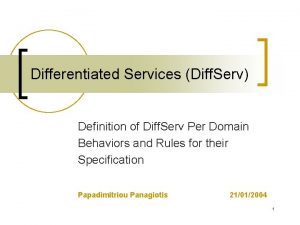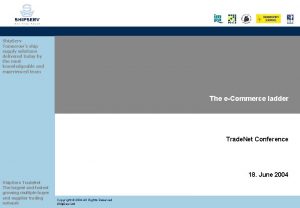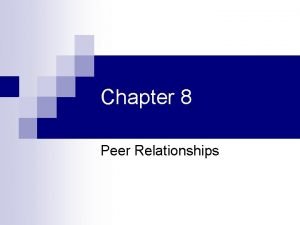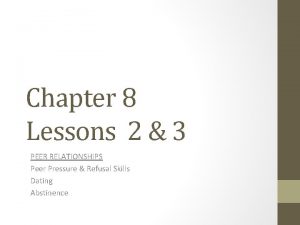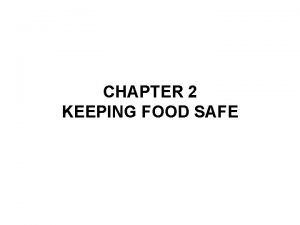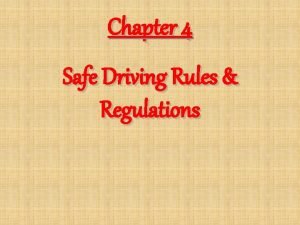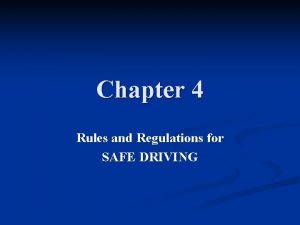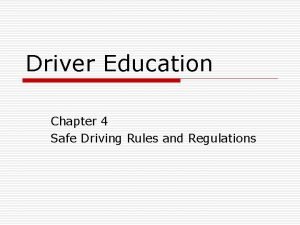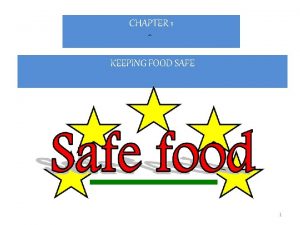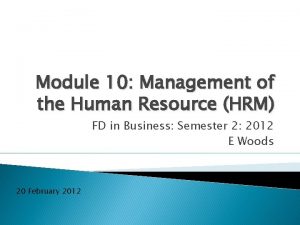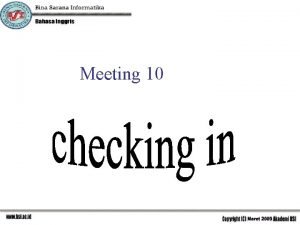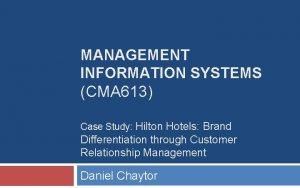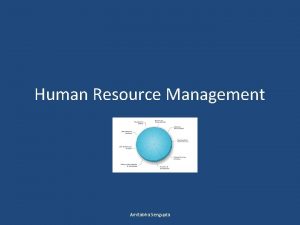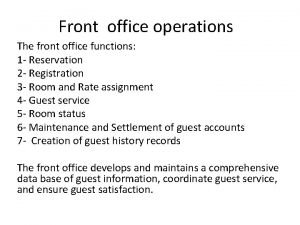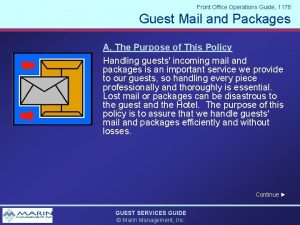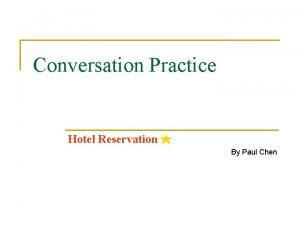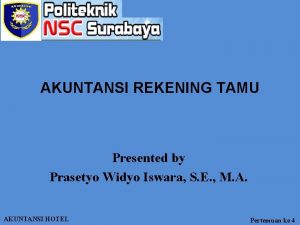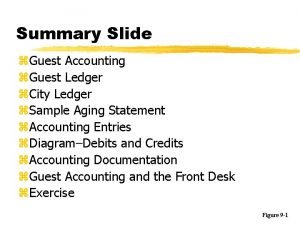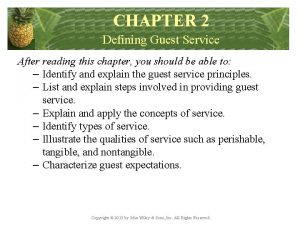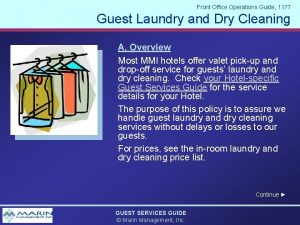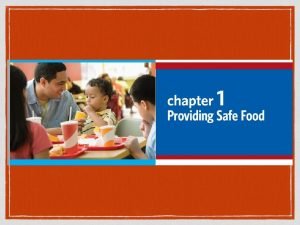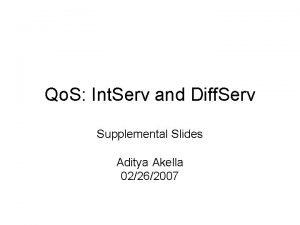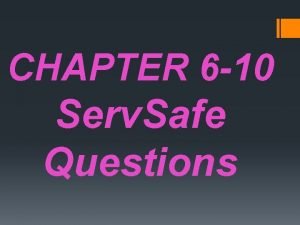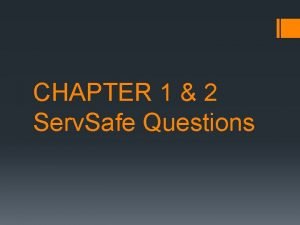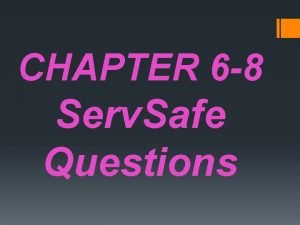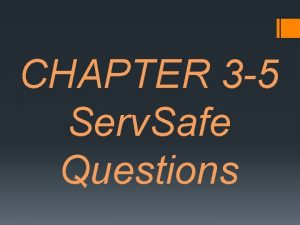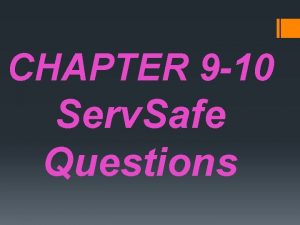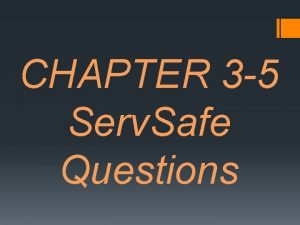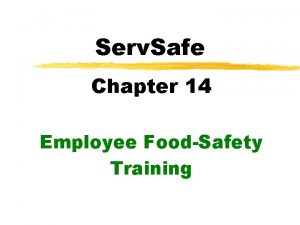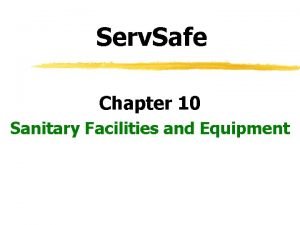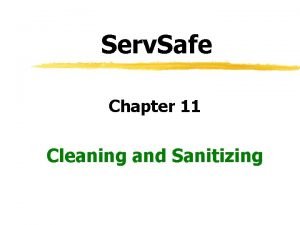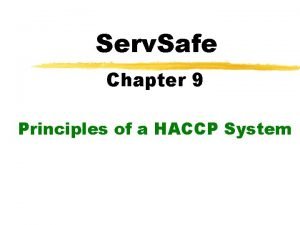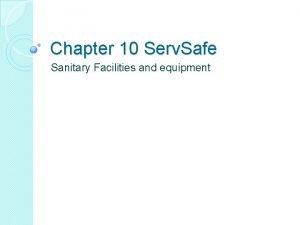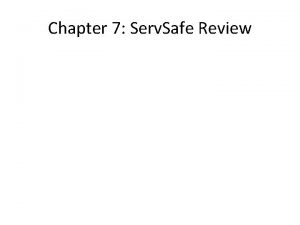CHAPTER 1 2 Serv Safe Questions A guest


































































- Slides: 66

CHAPTER 1 & 2 Serv. Safe Questions

A guest had a reversal of hot and cold sensations after eating seafood. What most likely caused the illness? A B C D Toxin Virus Bacteria Parasite

A guest had a reversal of hot and cold sensations after eating seafood. What most likely caused the illness? A B C D Toxin Virus Bacteria Parasite

A food handler stored a sanitizer spray bottle on the shelf above the prep table that had just been sanitized. Throughout the day, the food handler used the sanitizer on the prep table, storing it in the same spot. What should the food handler have done differently? A Stored the sanitizer bottle away from the prep area B Stored the sanitizer bottle on the floor between uses C Stored the sanitizer bottle on the prep table between uses D Stored the sanitizer bottle with food supplies below the prep table

A food handler stored a sanitizer spray bottle on the shelf above the prep table that had just been sanitized. Throughout the day, the food handler used the sanitizer on the prep table, storing it in the same spot. What should the food handler have done differently? A Stored the sanitizer bottle away from the prep area B Stored the sanitizer bottle on the floor between uses C Stored the sanitizer bottle on the prep table between uses D Stored the sanitizer bottle with food supplies below the prep table

To prevent the deliberate contamination of food, a manager should know who is in the facility, monitor the security of products, keep information related to food security on file, and know A B C D when to register with the EPA. how to fill out an incident report. where to find MSDS in the operation. who to contact about suspicious activity.

To prevent the deliberate contamination of food, a manager should know who is in the facility, monitor the security of products, keep information related to food security on file, and know A B C D when to register with the EPA. how to fill out an incident report. where to find MSDS in the operation. who to contact about suspicious activity.

What should food handlers do to prevent food allergens from being transferred to food? A B C D Clean and sanitize utensils after use. Buy from approved, reputable suppliers. Store cold food at 41°F (5°C) or lower. Label chemical containers correctly.

What should food handlers do to prevent food allergens from being transferred to food? A B C D Clean and sanitize utensils after use. Buy from approved, reputable suppliers. Store cold food at 41°F (5°C) or lower. Label chemical containers correctly.

A guest called a restaurant and told the manager about getting sick after eating there. The guest complained of vomiting and diarrhea a few hours after eating the raw oysters. What pathogen probably caused the illness? A B C D Norovirus Shigella spp. Salmonella Typhi Shiga toxin-producing E. coli

A guest called a restaurant and told the manager about getting sick after eating there. The guest complained of vomiting and diarrhea a few hours after eating the raw oysters. What pathogen probably caused the illness? A B C D Norovirus Shigella spp. Salmonella Typhi Shiga toxin-producing E. coli

Why are preschool-age children at a higher risk for food borne illnesses? A They have not built up strong immune systems. B They are more likely to spend time in a hospital. C They are more likely to suffer allergic ‘ reactions. D Their appetites have increased since birth.

Why are preschool-age children at a higher risk for food borne illnesses? A They have not built up strong immune systems. B They are more likely to spend time in a hospital. C They are more likely to suffer allergic ‘ reactions. D Their appetites have increased since birth.

Which is a TCS food? A B C D Bread Flour Sprouts Strawberries

Which is a TCS food? A B C D Bread Flour Sprouts Strawberries

The 5 common mistakes that can lead to foodborne illness are failing to cook food adequately, holding food at incorrect temperatures, using contaminated equipment, practicing poor personal hygiene, and A B C D reheating leftover food. serving ready-to-eat food. usingle-use, disposable gloves. purchasing food from unsafe sources.

The 5 common mistakes that can lead to foodborne illness are failing to cook food adequately, holding food at incorrect temperatures, using contaminated equipment, practicing poor personal hygiene, and A B C D reheating leftover food. serving ready-to-eat food. usingle-use, disposable gloves. purchasing food from unsafe sources.

What is an important measure for preventing food borne illness? A B C D Serving locally grown food Using new equipment Measuring pathogens Controlling time and temperature

What is an important measure for preventing food borne illness? A Serving locally grown food B Using new equipment C Measuring pathogens D Controlling time and temperature

Raw chicken breasts are left out at room temperature on a prep table. What is the risk that could cause a food borne illness? A B C D Cross-contamination Poor cleaning and sanitizing Poor personal hygiene Time-temperature abuse

Raw chicken breasts are left out at room temperature on a prep table. What is the risk that could cause a food borne illness? A B C D Cross-contamination Poor cleaning and sanitizing Poor personal hygiene Time-temperature abuse

A server cleans a dining table with a wiping cloth and then puts the cloth in an apron pocket. What is the risk that could cause a food borne illness? A B C D Cross-contamination Poor cleaning and sanitizing Poor personal hygiene Time-temperature abuse

A server cleans a dining table with a wiping cloth and then puts the cloth in an apron pocket. What is the risk that could cause a food borne illness? A B C D Cross-contamination Poor cleaning and sanitizing Poor personal hygiene Time-temperature abuse

What is the most important way to prevent a foodborne illness from bacteria? A B C D Control time and temperature. Prevent cross-contamination. Practice good personal hygiene. Practice good cleaning and sanitizing.

What is the most important way to prevent a foodborne illness from bacteria? A B C D Control time and temperature. Prevent cross-contamination. Practice good personal hygiene. Practice good cleaning and sanitizing.

What are the most common symptoms of a food borne illness? A Diarrhea, vomiting, fever, nausea, abdominal cramps, and dizziness B Diarrhea, vomiting, fever, nausea, abdominal cramps, and headache C Diarrhea, vomiting, fever, nausea, abdominal cramps, and jaundice D Diarrhea, vomiting, fever, nausea, abdominal cramps, and tiredness

What are the most common symptoms of a food borne illness? A Diarrhea, vomiting, fever, nausea, abdominal cramps, and dizziness B Diarrhea, vomiting, fever, nausea, abdominal cramps, and headache C Diarrhea, vomiting, fever, nausea, abdominal cramps, and jaundice D Diarrhea, vomiting, fever, nausea, abdominal cramps, and tiredness

Shiga toxin-producing E. coli (STEC) is commonly linked with what type of food? A B C D Potato salad Thick stews Dairy products Raw ground beef

Shiga toxin-producing E. coli (STEC) is commonly linked with what type of food? A B C D Potato salad Thick stews Dairy products Raw ground beef

What is the most important way to prevent a food borne illness from viruses? A B C D Control time and temperature. Prevent cross-contamination. Practice good personal hygiene. Practice good cleaning and sanitizing.

What is the most important way to prevent a food borne illness from viruses? A B C D Control time and temperature. Prevent cross-contamination. Practice good personal hygiene. Practice good cleaning and sanitizing.

Parasites are commonly linked with what type of food? A B C D Rice Poultry Seafood Canned food

Parasites are commonly linked with what type of food? A B C D Rice Poultry Seafood Canned food

CHAPTER 1 & 2 Serv. Safe Questions

Why are preschool-age children at a higher risk for food borne illnesses? A They have not built up strong immune systems. B They are more likely to spend time in a hospital. C They are more likely to suffer allergic ‘ reactions. D Their appetites have increased since birth.

Why are preschool-age children at a higher risk for food borne illnesses? A They have not built up strong immune systems. B They are more likely to spend time in a hospital. C They are more likely to suffer allergic ‘ reactions. D Their appetites have increased since birth.

Raw chicken breasts are left out at room temperature on a prep table. What is the risk that could cause a food borne illness? A B C D Cross-contamination Poor cleaning and sanitizing Poor personal hygiene Time-temperature abuse

Raw chicken breasts are left out at room temperature on a prep table. What is the risk that could cause a food borne illness? A B C D Cross-contamination Poor cleaning and sanitizing Poor personal hygiene Time-temperature abuse

What is the most important way to prevent a foodborne illness from bacteria? A B C D Control time and temperature. Prevent cross-contamination. Practice good personal hygiene. Practice good cleaning and sanitizing.

What is the most important way to prevent a foodborne illness from bacteria? A B C D Control time and temperature. Prevent cross-contamination. Practice good personal hygiene. Practice good cleaning and sanitizing.

To prevent the deliberate contamination of food, a manager should know who is in the facility, monitor the security of products, keep information related to food security on file, and know A B C D when to register with the EPA. how to fill out an incident report. where to find MSDS in the operation. who to contact about suspicious activity.

To prevent the deliberate contamination of food, a manager should know who is in the facility, monitor the security of products, keep information related to food security on file, and know A B C D when to register with the EPA. how to fill out an incident report. where to find MSDS in the operation. who to contact about suspicious activity.

What are the most common symptoms of a food borne illness? A Diarrhea, vomiting, fever, nausea, abdominal cramps, and dizziness B Diarrhea, vomiting, fever, nausea, abdominal cramps, and headache C Diarrhea, vomiting, fever, nausea, abdominal cramps, and jaundice D Diarrhea, vomiting, fever, nausea, abdominal cramps, and tiredness

What are the most common symptoms of a food borne illness? A Diarrhea, vomiting, fever, nausea, abdominal cramps, and dizziness B Diarrhea, vomiting, fever, nausea, abdominal cramps, and headache C Diarrhea, vomiting, fever, nausea, abdominal cramps, and jaundice D Diarrhea, vomiting, fever, nausea, abdominal cramps, and tiredness

Which is a TCS food? A B C D Bread Flour Sprouts Strawberries

Which is a TCS food? A B C D Bread Flour Sprouts Strawberries

What is an important measure for preventing food borne illness? A B C D Serving locally grown food Using new equipment Measuring pathogens Controlling time and temperature

What is an important measure for preventing food borne illness? A Serving locally grown food B Using new equipment C Measuring pathogens D Controlling time and temperature

The 5 common mistakes that can lead to foodborne illness are failing to cook food adequately, holding food at incorrect temperatures, using contaminated equipment, practicing poor personal hygiene, and A B C D reheating leftover food. serving ready-to-eat food. usingle-use, disposable gloves. purchasing food from unsafe sources.

The 5 common mistakes that can lead to foodborne illness are failing to cook food adequately, holding food at incorrect temperatures, using contaminated equipment, practicing poor personal hygiene, and A B C D reheating leftover food. serving ready-to-eat food. usingle-use, disposable gloves. purchasing food from unsafe sources.

Shiga toxin-producing E. coli (STEC) is commonly linked with what type of food? A B C D Potato salad Thick stews Dairy products Raw ground beef

Shiga toxin-producing E. coli (STEC) is commonly linked with what type of food? A B C D Potato salad Thick stews Dairy products Raw ground beef

What is the most important way to prevent a food borne illness from viruses? A B C D Control time and temperature. Prevent cross-contamination. Practice good personal hygiene. Practice good cleaning and sanitizing.

What is the most important way to prevent a food borne illness from viruses? A B C D Control time and temperature. Prevent cross-contamination. Practice good personal hygiene. Practice good cleaning and sanitizing.

A server cleans a dining table with a wiping cloth and then puts the cloth in an apron pocket. What is the risk that could cause a food borne illness? A B C D Cross-contamination Poor cleaning and sanitizing Poor personal hygiene Time-temperature abuse

A server cleans a dining table with a wiping cloth and then puts the cloth in an apron pocket. What is the risk that could cause a food borne illness? A B C D Cross-contamination Poor cleaning and sanitizing Poor personal hygiene Time-temperature abuse

Parasites are commonly linked with what type of food? A B C D Rice Poultry Seafood Canned food

Parasites are commonly linked with what type of food? A B C D Rice Poultry Seafood Canned food

What should food handlers do to prevent food allergens from being transferred to food? A B C D Clean and sanitize utensils after use. Buy from approved, reputable suppliers. Store cold food at 41°F (5°C) or lower. Label chemical containers correctly.

What should food handlers do to prevent food allergens from being transferred to food? A B C D Clean and sanitize utensils after use. Buy from approved, reputable suppliers. Store cold food at 41°F (5°C) or lower. Label chemical containers correctly.

A food handler stored a sanitizer spray bottle on the shelf above the prep table that had just been sanitized. Throughout the day, the food handler used the sanitizer on the prep table, storing it in the same spot. What should the food handler have done differently? A Stored the sanitizer bottle away from the prep area B Stored the sanitizer bottle on the floor between uses C Stored the sanitizer bottle on the prep table between uses D Stored the sanitizer bottle with food supplies below the prep table

A food handler stored a sanitizer spray bottle on the shelf above the prep table that had just been sanitized. Throughout the day, the food handler used the sanitizer on the prep table, storing it in the same spot. What should the food handler have done differently? A Stored the sanitizer bottle away from the prep area B Stored the sanitizer bottle on the floor between uses C Stored the sanitizer bottle on the prep table between uses D Stored the sanitizer bottle with food supplies below the prep table

A guest called a restaurant and told the manager about getting sick after eating there. The guest complained of vomiting and diarrhea a few hours after eating the raw oysters. What pathogen probably caused the illness? A B C D Norovirus Shigella spp. Salmonella Typhi Shiga toxin-producing E. coli

A guest called a restaurant and told the manager about getting sick after eating there. The guest complained of vomiting and diarrhea a few hours after eating the raw oysters. What pathogen probably caused the illness? A B C D Norovirus Shigella spp. Salmonella Typhi Shiga toxin-producing E. coli

A guest had a reversal of hot and cold sensations after eating seafood. What most likely caused the illness? A B C D Toxin Virus Bacteria Parasite

A guest had a reversal of hot and cold sensations after eating seafood. What most likely caused the illness? A B C D Toxin Virus Bacteria Parasite
 Safe feed safe food
Safe feed safe food Safe people safe places
Safe people safe places Atradius serv net
Atradius serv net Int serv
Int serv Derivserv
Derivserv Diff serv
Diff serv Expektoráció jelentése
Expektoráció jelentése Que son los servicios diferenciados
Que son los servicios diferenciados Apa serv alexandria
Apa serv alexandria How to use brutus password cracker
How to use brutus password cracker Ship serv
Ship serv Chapter 8 healthy peer relationships
Chapter 8 healthy peer relationships Chapter 8 peer relationships answer key
Chapter 8 peer relationships answer key Chapter 2 keeping food safe
Chapter 2 keeping food safe If a motorist’s vehicle becomes disabled he/she must
If a motorist’s vehicle becomes disabled he/she must Chapter 4 safe driving rules and regulations
Chapter 4 safe driving rules and regulations Chapter 4 safe driving rules and regulations
Chapter 4 safe driving rules and regulations Chapter 4 safe driving rules and regulations
Chapter 4 safe driving rules and regulations Potentially hazardous food is usually moist
Potentially hazardous food is usually moist Chapter 19 safe for democracy
Chapter 19 safe for democracy Chapter 8 lesson 1 safe and healthy friendships
Chapter 8 lesson 1 safe and healthy friendships Etihad guest email
Etihad guest email Wireless guest access solution
Wireless guest access solution Welcome to our honorable guests
Welcome to our honorable guests Harris burdick
Harris burdick Welcome address for webinar sample
Welcome address for webinar sample Meraki splash page
Meraki splash page Don't boast about yourself
Don't boast about yourself Guest ledger adalah
Guest ledger adalah Standards in preparing guest clothes and shoes
Standards in preparing guest clothes and shoes Provide housekeeping services to guests
Provide housekeeping services to guests .php?title=
.php?title= Engagement zone utrgv
Engagement zone utrgv Nasa guest account
Nasa guest account David guest model of hrm
David guest model of hrm Receptionist dialogue
Receptionist dialogue Guest experience cycle
Guest experience cycle Fombrun tichy and devanna model
Fombrun tichy and devanna model Departure of guests
Departure of guests Guest inn greece
Guest inn greece Guest charges
Guest charges Front desk functions
Front desk functions Current guest mail
Current guest mail Conversation for booking a room in hotel
Conversation for booking a room in hotel Nac guest server
Nac guest server Being brave at night poem summary
Being brave at night poem summary Contoh transaksi akuntansi hotel
Contoh transaksi akuntansi hotel Pamela guest
Pamela guest A guest with relaxed inhibitions may
A guest with relaxed inhibitions may Ncsu guest wifi
Ncsu guest wifi What quite unmanned in folly
What quite unmanned in folly Guest accounting
Guest accounting Guest cycle
Guest cycle Front office accounting
Front office accounting Honeywell inncom
Honeywell inncom Guest service definition
Guest service definition Advocating guest passion
Advocating guest passion One pager the great gatsby
One pager the great gatsby Greet guest
Greet guest Guest hopping attack
Guest hopping attack 5-a-day language review
5-a-day language review Missing dollar question
Missing dollar question Guest satisfaction tracking system
Guest satisfaction tracking system Guest teacher expectations
Guest teacher expectations How will you bill and deliver the guest laundry
How will you bill and deliver the guest laundry Cisco systems g.k.
Cisco systems g.k. Hku moodle guest
Hku moodle guest


